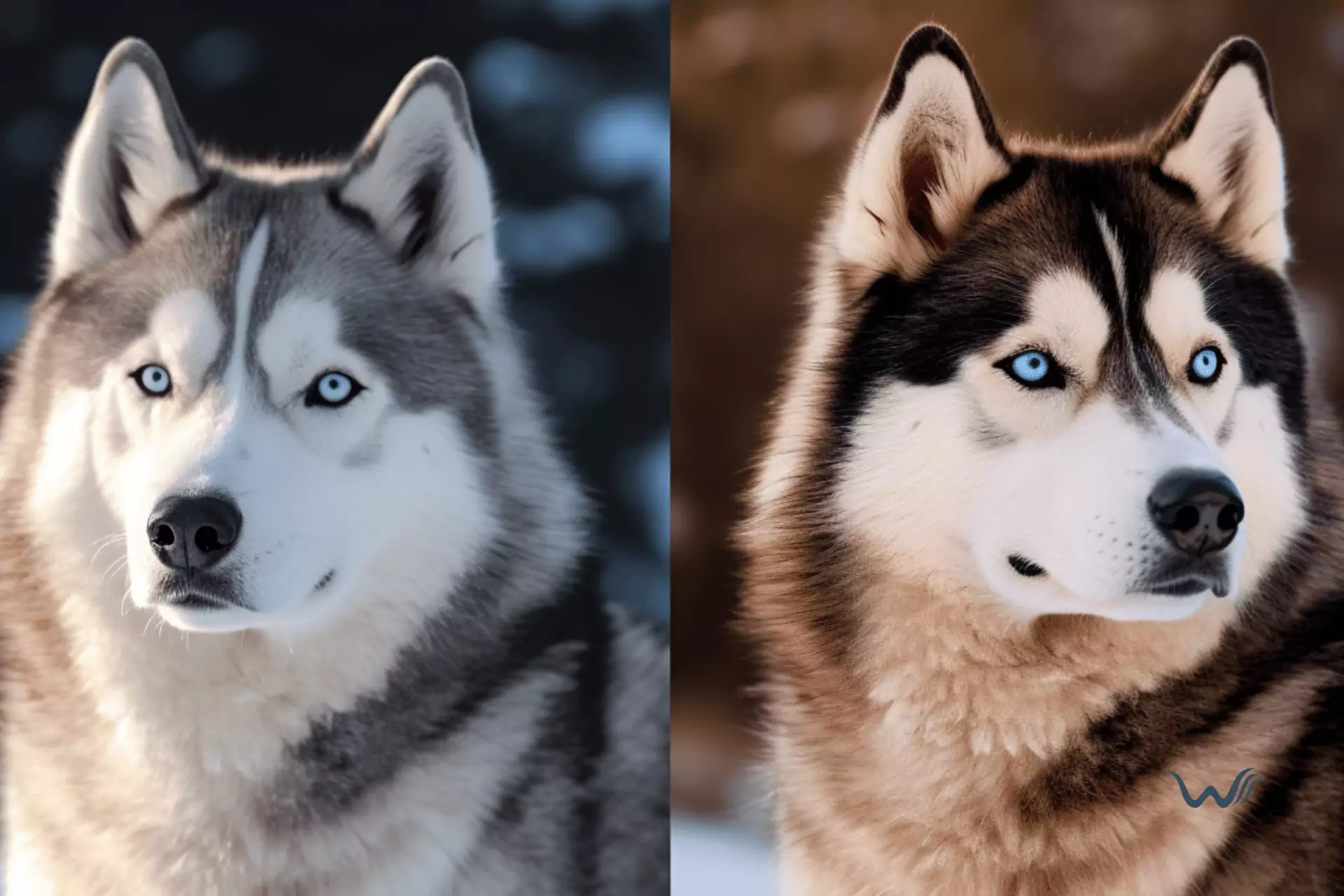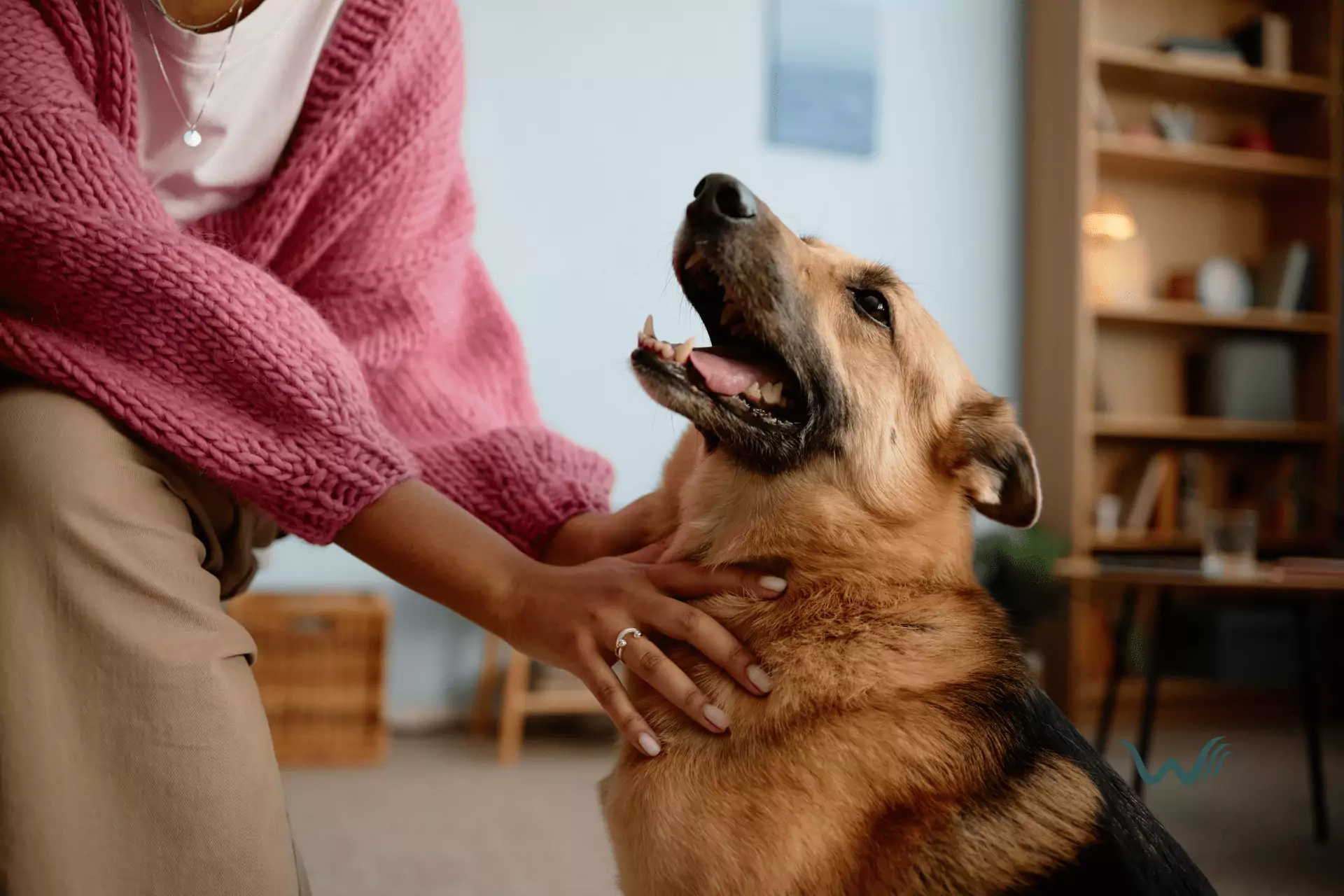

7 Important Differences Between A Husky And Malamute
by Haley Mills
Last updated: July 14, 2025
Verified and Approved by:
Angela Morris,
MSW, LCSW
Fact Checked

Have you ever gazed into the eyes of a majestic canine, captivated by their beauty and strength? The world of sled dogs offers a plethora of such magnificent creatures, but two breeds stand out among the rest – the husky and the malamute.
Like two sides of the same coin, these dogs share similarities in their appearance and purpose, but they also possess distinct differences that set them apart. This article will explore seven differences between a husky and a malamute, shedding light on their physical attributes, temperaments, exercise needs, grooming requirements, trainability, health, and historical origins.
When it comes to physical appearance, the husky and malamute each possess their own unique charm. The husky, known for its striking blue or multi-colored eyes, has a slender and athletic build, exuding grace and agility. On the other hand, the malamute, with its strong and robust frame, emanates power and strength.
While both breeds have thick double coats to protect them from the harshest of climates, the husky’s coat is usually shorter and less dense, while the malamute’s coat is longer and more insulating. As for size, the husky typically stands at a height of 21 to 24 inches and weighs between 35 to 60 pounds, whereas the malamute is larger, standing at 23 to 25 inches tall and weighing between 75 to 100 pounds.
With their captivating looks, it is easy to see why these breeds have become popular choices for dog lovers worldwide. However, their temperaments and personalities differ greatly. Huskies are known for their outgoing and social nature, often described as friendly and playful. They are highly sociable and enjoy the company of humans and other dogs alike.
Malamutes are more independent and reserved, often displaying a strong sense of loyalty and protectiveness towards their family. They are known to be more aloof and cautious around strangers, making them excellent guard dogs. Understanding these differences in temperament is crucial in choosing the right breed to fit your lifestyle and home environment.
Physical Appearance and Size
So you think you’ve got what it takes to tell a husky from a malamute? Well, let me tell you, these two majestic breeds’ physical appearance and size is like night and day.
While both the husky and malamute are large, well-built dogs, some distinct differences set them apart.
Firstly, let’s talk about size. Huskies are generally smaller than malamutes, with males typically weighing between 45-60 pounds and standing at around 21-23.5 inches tall at the shoulder. Females are slightly smaller, weighing between 35-50 pounds and measuring around 20-22 inches in height.
Male malamutes can weigh anywhere from 75-100 pounds and stand at around 24-26 inches tall, while females can weigh between 65-85 pounds and measure approximately 22-24 inches in height. So if you come across a dog that is on the larger side, chances are it’s a malamute.
Another noticeable difference is their coat colors. Huskies come in various colors and patterns, including black, white, gray, red, sable, and agouti. They often have striking markings on their faces and bodies, with their eyes typically blue or a combination of blue and brown.
Malamutes have a more limited range of colors, with the most common being black, gray, sable, and red. They usually have a solid color coat and their eyes are typically brown or amber. So if you see a dog with vivid blue eyes, it’s most likely a husky.
When it comes to vocalization tendencies, both breeds are known for being quite talkative. However, huskies are generally more vocal than malamutes. They tend to howl, yelp, and “talk” to communicate with their owners.
Malamutes, on the other hand, are known for being more quiet and reserved. They are not as prone to excessive barking or howling. So if you encounter a dog that loves to make its voice heard, it’s probably a husky. Malamutes are also larger, have a more limited range of coat colors, and are usually quieter. Understanding these differences can help you accurately identify and appreciate these beautiful breeds.
Tail Position and Eye Variations
Another way to tell these breeds apart is by looking at their tails. Huskies typically have a brush tail that points downward, contributing to their sleek, wolf-like appearance. Malamutes, on the other hand, carry their thick, plume-like tails over their backs—a classic trait of the breed.
And while huskies are famous for their striking blue eyes, not all of them have this feature. Some may have brown eyes, and others may even have one blue and one brown eye—a condition known as heterochromia. Malamutes almost always have brown or amber eyes, adding to their more earthy, serious expression.
Additional Insight: Social Needs and Pack Behavior
While both breeds are pack animals and loyal to their families, huskies are much more social and dislike being left alone. They crave companionship—whether from people or other pets—and can become anxious or destructive if left for long periods.
Malamutes, though affectionate, tend to be more independent. They can handle alone time better and often thrive as the only pet in the household. While both breeds are friendly, malamutes are more reserved with strangers and may be more selective in their social interactions. Early socialization is especially important for either breed to develop balanced behavior.
Temperament and Personality Traits
Both huskies and malamutes display unique temperaments and personality traits. Huskies are known for their friendly and outgoing nature. They’re generally good with children and other dogs, making them an excellent choice for families. However, huskies can also be quite independent and stubborn at times. They have a strong prey drive and may chase small animals if they’re not properly trained and socialized.
Additionally, huskies tend to be aggressive, especially towards other dogs of the same sex. Be sure to provide them with consistent training and socialization from a young age to prevent any behavioral issues.
Malamutes are known for their gentle and affectionate nature. They’re often described as being more laid-back and easygoing compared to huskies. Malamutes are generally good with children and are known to be very patient and tolerant. However, they can be more dominant and strong-willed, sometimes leading to a more challenging training experience.
Malamutes also have a high prey drive and may exhibit aggression towards small animals. Try to socialize them properly and provide consistent training to ensure they become well-behaved and obedient companions.
Exercise and Activity Needs
Huskies and Malamutes have varying exercise and activity needs. Both breeds are highly active and require regular exercise to stay healthy and happy. However, there are some differences in their exercise intensity and mental stimulation requirements.
Huskies are known for their high energy levels and need much exercise to burn off their energy. They are bred to be sled dogs and have a strong instinct to run. Huskies should ideally have at least two hours of vigorous exercise daily, such as running, hiking, or playing fetch. They thrive in environments where they can engage in activities that allow them to use their natural athleticism.
In addition to physical exercise, Huskies also require mental stimulation to prevent boredom and destructive behaviors. Puzzle toys, obedience training, and interactive games can help keep their minds occupied.
On the other hand, Malamutes have a slightly lower exercise intensity compared to Huskies. They are also bred for pulling sleds but have a more relaxed and independent nature. Malamutes still require daily exercise but are less demanding than Huskies. A long walk or a moderate play session in a fenced yard can meet their exercise needs.
Mental stimulation is also essential for Malamutes, but they may not require as much mental exercise as Huskies. Providing them with toys that challenge their problem-solving skills or engaging in obedience training can help keep them mentally stimulated.
Containment Challenges: Fencing and Escape Tendencies
Both Huskies and Malamutes are known escape artists—but in different ways. Huskies have a strong instinct to run and may bolt if not secured. They can jump high fences or squeeze through surprisingly small gaps, so a tall, sturdy fence or leash is essential when they’re outside.
Malamutes, on the other hand, love to dig. A standard fence may not be enough to contain them, especially if they decide to tunnel underneath. For these determined diggers, consider reinforcing your yard with dig-proof barriers or extending fencing underground to keep them safely enclosed.
Understanding each breed’s escape tendencies will help you create a secure space and prevent unplanned adventures.
Grooming Requirements
To keep your furry companion looking their best, you’ll need to groom them regularly. Both huskies and malamutes have thick double coats that require regular brushing to prevent matting and keep their fur clean and healthy. However, there are some differences in their grooming requirements.
Huskies have a medium-length coat with a dense undercoat. They are known for their heavy shedding, which occurs twice a year, known as “blowing their coat.” During this time, they shed their entire undercoat, and the amount of fur they shed can be quite overwhelming. To manage this shedding, huskies require more frequent brushing during these periods to remove loose fur and prevent matting.
Outside of the shedding season, huskies still shed moderately, so regular brushing is necessary to maintain their coat.
Malamutes have a thick, coarse coat with a woolly undercoat. They also shed, but not as heavily as huskies. Malamutes typically shed once or twice a year, and their shedding is less noticeable compared to huskies. However, they still require regular brushing to remove loose fur and maintain their coat’s health. The texture of their coat may also require occasional trimming to keep it looking neat and tidy.
Trainability and Intelligence
With their sharp minds and quick learning abilities, training a husky or malamute is like teaching a talented artist to create a masterpiece. Both breeds are intelligent and have the potential to excel in training, but they may present some challenges along the way.
Huskies and malamutes are known for their independent nature, which can sometimes make them stubborn and resistant to commands. This independence and high energy levels can make keeping their attention focused during training sessions challenging. Consistency, patience, and positive reinforcement are key in training these breeds.
While both huskies and malamutes are intelligent, they may differ in their problem-solving abilities. Huskies are known for their cleverness and ability to think outside the box. They can quickly learn new commands and tricks and may even find ways to bypass training methods that they find uninteresting or repetitive. On the other hand, malamutes tend to be more methodical in their thinking. They may take a bit longer to grasp new concepts, but once they do, they are known for their reliability and consistency in executing commands. Both breeds can benefit from mental stimulation and interactive toys to keep their minds sharp and engaged.
House Training Differences
When it comes to house training, you’ll likely notice a difference between the two breeds. Huskies, while occasionally stubborn, generally pick up on house training with a bit more ease—especially if you stick to a consistent routine and reward good behavior.
Malamutes, however, can present more of a challenge in this area. They often require extra patience and perseverance, as they may take longer to fully grasp house training rules. Expect to invest more time (and perhaps a few extra cleaning supplies) to help a Malamute master this important skill. Consistent schedules, positive reinforcement, and a good dose of persistence will go a long way with both breeds, but especially with the independent-minded Malamute.
Health and Lifespan
While both breeds are usually healthy, they have some common health issues specific to their breed. Huskies are prone to certain conditions, such as hip dysplasia, eye problems (cataracts and progressive retinal atrophy), and skin allergies. Husky owners need to be aware of these potential health issues and provide regular veterinary care to prevent or treat any conditions.
Malamutes are generally a healthy breed with less common health issues than huskies. However, they can still be prone to certain conditions, such as hip dysplasia and a hereditary condition called polyneuropathy, which affects the nerves and can cause weakness or paralysis in the hind limbs. It is crucial for malamute owners to be aware of these potential health issues and to provide regular veterinary care to ensure their dog’s well-being.
The average lifespan for a husky is around 12 to 14 years, while the average lifespan for a malamute is slightly shorter at around 10 to 12 years. However, individual lifespans can vary based on various factors such as genetics, diet, exercise, and overall health care. Proper nutrition, regular exercise, and routine veterinary care can help huskies and malamutes live long and healthy lives.
What are the key differences between a Miniature German Shepherd and a Husky or Malamute?
Miniature German Shepherd breed details reveal that they are a smaller version of the traditional German Shepherd, while Huskies and Malamutes are larger northern dog breeds. Miniature German Shepherds typically have a mix of German Shepherd and smaller dog breeds, whereas Huskies and Malamutes have distinct characteristics and are bred for specific purposes.
Historical Origins and Purpose
Imagine yourself transported back in time to the snowy landscapes of ancient arctic regions, where the husky and malamute first emerged to fulfill their unique historical purposes.
Both breeds have distinct breed characteristics that have allowed them to adapt and thrive in harsh environments. The husky, known for its endurance and speed, was bred by the Chukchi people of northeastern Siberia to assist with transportation over long distances. These dogs were valued for their ability to pull sleds and their efficiency in covering vast expanses of snow and ice.
The malamute originated from the Inuit people of Alaska and was bred for its strength and power. These dogs were used for hauling heavy loads and were essential for the survival of the Inuit communities.
The cultural significance of these breeds cannot be overstated. The husky and malamute played crucial roles in the lives of indigenous peoples, as they were relied upon for transportation, hunting, and companionship. The Chukchi and Inuit cultures valued these dogs and considered them integral to their communities.
The husky and malamute were highly regarded for their loyalty, intelligence, and ability to withstand extreme cold temperatures. Today, their historical origins and purposes are still celebrated and acknowledged, with both breeds continuing to be popular choices for working dogs and beloved family pets.
How much does a Husky or Malamute puppy cost?
Husky and Malamute puppies from reputable breeders typically cost between $800 and $2,000, depending on factors like lineage, breeder reputation, and AKC registration. You might find lower-cost options through breed-specific rescues or shelters, though puppies are less commonly available there. Always prioritize health and ethical breeding practices when choosing your new companion.
What are some good alternatives to Huskies and Malamutes?
If you love the look or energy of Huskies and Malamutes but feel they might not fit your lifestyle, consider breeds like the Samoyed, American Eskimo Dog, or Australian Shepherd. These dogs often share similar traits but may be easier to manage in terms of grooming or activity needs. You can also explore adopting a rescue dog—shelters are full of wonderful mixed-breed companions who could be a perfect match for your home and energy level.
Wrapping Up
From a physical standpoint, huskies tend to be smaller and more slender, while malamutes are larger and more muscular.
In terms of temperament, huskies are known for their friendly and outgoing nature, while malamutes are often described as more reserved and independent.
When it comes to exercise and activity needs, both breeds require a significant amount of exercise to stay happy and healthy. However, huskies have a higher energy level and may need more intense exercise, such as running or hiking, to satisfy them. Conversely, malamutes are known for their endurance and can handle longer periods of physical activity.
Huskies have a dense double coat that requires regular brushing to prevent matting and shedding. Malamutes also have a thick coat, but their fur tends to be coarser and may require less frequent grooming. However, both breeds are known for their heavy shedding, so regular brushing is essential for both.
Regarding trainability and intelligence, huskies are generally more independent and can sometimes be stubborn. They’re known for their intelligence but may require more patience and consistency in training. Malamutes are highly intelligent but can be more willful and independent, making training more challenging.
Huskies and malamutes are generally healthy breeds. However, huskies are prone to specific health issues such as hip dysplasia and eye problems. Malamutes are generally healthier but may be more susceptible to certain genetic conditions such as hip dysplasia and arthritis.
Lastly, these two breeds’ historical origins and purpose play a significant role in their differences. Huskies were originally bred as sled dogs and had a long history of pulling heavy loads over long distances. On the other hand, Malamutes were bred as working dogs and used for tasks such as hauling heavy loads and sled pulling.
From their physical appearance and size to their temperament and personality traits, these differences can significantly impact the type of care and training each breed requires. Understanding these distinctions can help potential owners decide between a husky and a malamute.
Certify Your Emotional Support Animal Today

Why You Can Rely on Us?
At Wellness Wag, we believe your pet deserves care rooted in both science and compassion. Each article is carefully researched, written in clear language for pet owners, and then reviewed by qualified professionals to ensure the information is evidence-based, current, and practical for real-life care. Our goal is to help you feel confident in making informed decisions about your pet’s health and well-being.
Reviewed by
Angela Morris, MSW, LCSW
Angela is a licensed clinical social worker with 20 years of experience in patient advocacy and community mental health. She has assisted numerous clients with ESA evaluations and brings a deep understanding of disability accommodations, ensuring that all information is accurate, supportive, and practical.

Written by :
Haley Mills
Last Updated :
July 14, 2025












